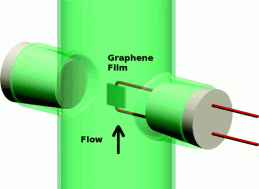Graphene harvests electrical energy from water to power microsensors
July 20, 2011

Water flow over graphene generates an induced voltage in the flow direction due to coupling of ions present in water with free charge carriers in the graphene (credit: Rensselaer Polytechnic Institute)
Researchers at Rensselaer Polytechnic Institute have developed a new method to harvest electrical energy from flowing water.
The researchers investigated how the flow of water over surfaces coated with graphene could generate small amounts of electricity. They demonstrated the creation of 85 nanowatts of power from a sheet of graphene measuring .03 millimeters by .015 millimeters.
This amount of energy should be sufficient to power tiny sensors that are introduced into water or other fluids and pumped down into a potential oil well, the researchers said.
They discovered that chloride ions present in the water stick to the surface of graphene. As water flows over the graphene, the friction force between the water flow and the layer of adsorbed chloride ions causes the ions to drift along the flow direction. The motion of these ions drags the free charges present in graphene along the flow direction, creating an internal current.
As injected water moves through naturally occurring cracks and crevices deep in the earth, the devices detect the presence of hydrocarbons and can help uncover hidden pockets of oil and natural gas. As long as water is flowing over the graphene-coated devices, they should be able to provide a reliable source of power, the researchers said. This power is necessary for the sensors to relay collected data and information back to the surface.
The researchers see applications for self-powered microrobots, microsubmarines, and harvesting power from a graphene coating on the underside of a boat.
Ref.: Prashant Dhiman, et al., Harvesting Energy from Water Flow over Graphene, Nano Letters, 2011; 110714113416089 [DOI: 10.1021/nl2011559]